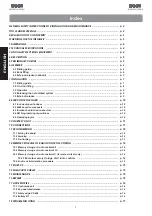
13
screw. This connection insures that the green valve
controls opening pressure.
Caution:
Do
not
remove and do
not
tighten the
elbow-shaped pipe fittings on the power unit.
They have been locked into position with a
thread locker to help seal the hydraulic system.
Synchronize the
Hydraulic System
Next you need to disengage the hydraulic system in
order to synchronize it.
Inside the power unit is the Manual Release lever that
disengages the hydraulic system (see Figure 1). Make
Figure 8. Connect the hydraulic line to the
power unit. See the technical drawing on the
next to last page for more information.
sure the Manual Release lever is turned toward you and
down to disengage the hydraulic system.
Now you can synchronize (set) the hydraulic system to
the closed position by turning the splined shaft in the
closing direction. Turn the shaft as far as it will go. To
prevent the piston in the drive unit from bottoming in its
cylinder, next turn the splined shaft about 5 deg in the
opening direction.
The position of the shaft now corresponds to the fully
closed position of the gate leaf. The hydraulic system is
now synchronized (set).
Caution
: The splined shaft must not be moved
from its closed position until the gate leaf shoe
that holds the gate leaf has been attached.
Install the Gate Leaf Shoe
If the vertical distance between the finished grade under
the gate and the bottom of the gate leaf is more than
1 1/4 in. (see Figure 5), you need to do one of the
following:
•
Install a length of appropriately sized pipe
between the sleeve that fits around the splined
shaft of the operator and the gate leaf shoe.
•
Construct a shear-pin assembly to
accommodate the extra vertical distance. The
assembly is welded to the bottom of the gate
leaf shoe on one end and to the sleeve for the
splined shaft of the pinion on the other end
(see Figures 9 and 10). Such an assembly
requires a bottom hinge and also protects the
pinion and splined shaft in the event something
hits the gate with great force.
Weld this end of this pipe to
the bottom of the gate leaf
shoe, being certain you have
aligned the axes of rotation.
This 2 in. pipe (schedule 160)
has an inside diameter of 1.689 in.
Weld this end of this pipe to the
sleeve for the splined shaft (do not
weld anything to the splined shaft
itself). This 1 1/4 in. pipe (schedule
160) has an outside diameter of
1.660 in.
Axis of rotation of the gate leaf
Bolt or shear pin goes
through these holes and
the holes on the opposite
sides of the pipes.
Figure 9. A sample shear-pin assembly
Installing the gate leaf shoe involves making the gate
leaf shoe, positioning it, and welding it to the splined
shaft sleeve. If you are retrofitting the 750 Operator to
an existing gate, these tasks require you to remove the
gate leaf from its hinges. If you are using a shear-pin
assembly, refer to Figures 9 and 10 to determine what
you should weld together.
The gate leaf shoe is designed to carry the weight of the
gate leaf and transfer the weight to the splined shaft.
The shoe surrounds the 90-deg gate-post corner of the
gate leaf to carry the gate and to act as a lower hinge.
The shoe is made of a U-shaped section and a vertical
section (see Figure 10). Later you will weld the bottom
of the U-shaped section to the sleeve for the splined
shaft (or to the shear-pin assembly, which is welded to
the sleeve).
Since the gate leaf shoe holds the gate leaf, both
sections must be made of steel at least 1/4 in. (0.6 cm)














































